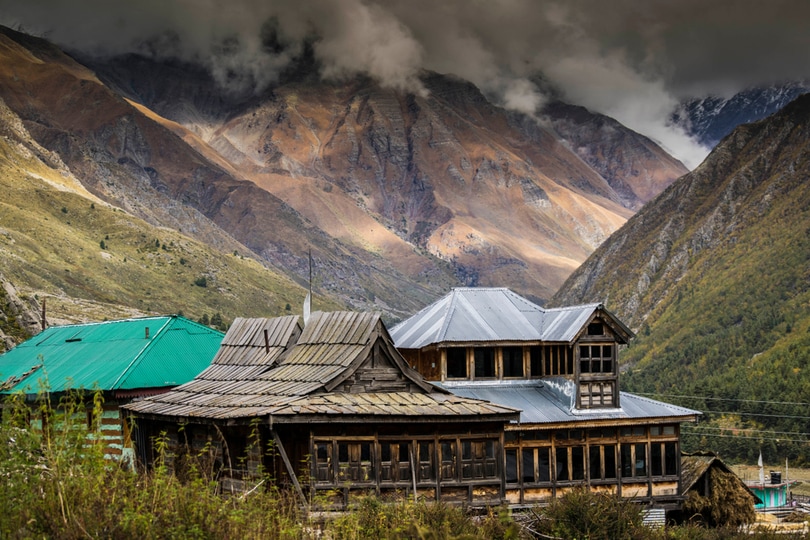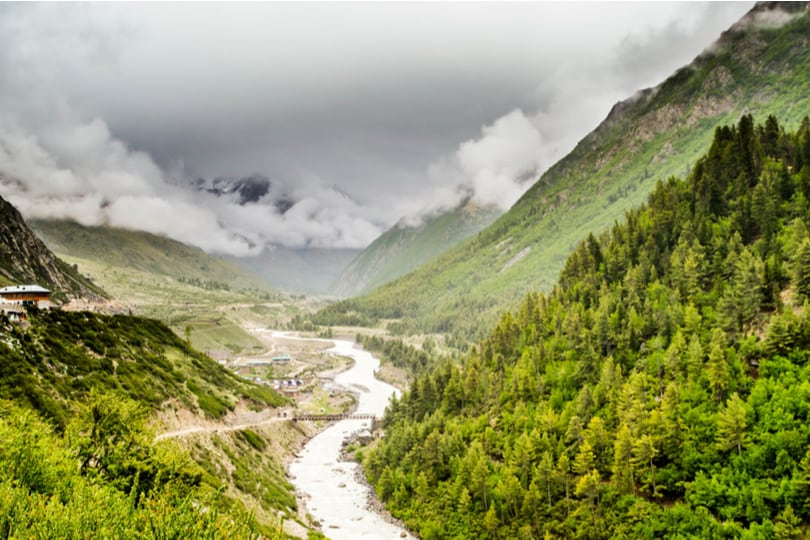

An enchanting hamlet located in Himachal Pradesh, Chitkul, is the last motorable settlement on the border of India and Tibet. The charming Chitkul Valley in Kinnaur District is on the banks of river Baspa. It is a doorway to do the winsome beauty of a landscape that is ornamented with exquisite meadows, a babbling river, and glorious mountains. The journey to the village is a life-changing experience where you will be able to revel in the realm of divine nature surrounding you. It a must-visit destination for adventure and nature enthusiasts. The organic and unadulterated atmosphere of Chitkul makes it a popular site for backpackers, campers, hikers, and explorers. The village dwellers are humble and welcoming people that host numerous tourists throughout the year.
Located on the rim of the old Indo-Tibetan road, the Chitkul village is at a height of 3,450 meters above sea level. Experiencing the village and its rawness involves seeing its indigenous wildlife, vegetation, terrain, and atmosphere. The culture and heritage of the town are eclectic. You can see this melange through the traditions, architecture, and ethics of the village and the villagers. With drifting water of Baspa River on one side and apple orchids on the other, Chitkul is a magnetic locus of serenity, divinity, and tranquillity.


The historical background of Chitkul Valley is vague as there are no concrete, authentic records. But you can get a glimpse into the tales of the past through the people and their lineage, as well as through their houses of worship and the relics they possess. According to prehistoric legends, the dwellers of Chitkul were called Kinnaras as they were believed to be halfway between a mortal and deity. They were considered to be midway between God and people mainly for the location of their home. The Kinnaur District was home to these supernatural beings as the place was a paradise that made you feel close to God while living in an earthly environment. The cultural and religious values in the village are diverse and secular. There is an influence of Buddhism, Hinduism, and Animalism. The village is dotted with ancient monasteries and temples. The local dialects predominantly spoken are Pahadi and Tibetan. Hindi is a common language to converse in for tourists.
The ideal way to explore Chitkul Valley in on foot using paths weaving through the village and the hillside. Not only is this more convenient than the rough motor routes, it also gives you the opportunity to drink in the heavenly environment and aura of the valley.
Dedicated to the local goddess Shri Mathi, the temple is said to be five centuries old. The statue of the goddess is made of wood in contrast to the stone statues commonly found in temples. The wood used to carve the statue was walnut wood. Shri Mathi is decorated and clothed with garments made of yak’s tail hair. According to folklore, the Devi settled in Chitkul Village after embarking on an arduous and long journey. Upon reaching the village she brought prosperity to the locals. The locals are loyal devotees and followers of the Goddess as she is considered to be their holy lucky charm. You must pay homage to the temple for spiritual healing as well as to witness the architectural marvel that it is. Recently restored, you will find the temple to be a mix of stone and wood. This combination is a unique architectural style of the Kinnauri tribe. The Mathi Temple is centrally located in the village.
The history behind the fort in ambiguous. Not only is the origin debatable but so is the structure. The fort that once served as a watchtower is one of the prominent attractions in the village. You can visit the fort to marvel at the architecture. It is intricately decorated with wooden carvings that are typical to the Pahadi style of art that uses mountain stones as its base. The three-story high tower offers an overview of the village and the valley.
The Aakhri Dhaba is the last local cafe of India. This is declared with pride on a big banner next to the cafe. This buzzing dhaba is located on the banks of River Baspa. It serves tasty local dishes and munchies and it the perfect pit stop for when you are hungry while exploring the valley.
One of the most picturesque valleys in the country, the Chitkul Village is blessed with the crystal clear and babbling waters of river Baspa. With the majestic Himalayas as its backdrop, the river is a popular site for trekking and water sports. You can take up river rafting and a woven coracle boat ride. The river is surrounded with thick, tall, green pine and oak trees. You can go fishing at the river to catch local trout fish. When you behold the river and the mountainous riverside, you will experience the true essence of Himachal Pradesh.
In the Chitkul Valley, you will get to relish authentic Pahadi culture through the vistas, the people, the traditions, but especially through the food. The food cooked in the local cafes and restaurants is packed with flavour and spices. The local produce will warm your heart and body in the cold weather. The staple street food in Chitkul is hot steamy momos stuffed aromatic meat or mashed vegetables. Another commonly found dish is Thukpa. Thukpa is a Tibetan noodle soup with meat and veggies. If you are looking for some quick bites that hit the spot, you will find many stalls that serve parathas and Maggi noodles.
Due to the high altitude, when it comes to the weather condition of Chitkul, it is always cold. However, the intensity of the cold changes seasonally. You must carry enough warm clothes with you when travelling to the valley. The days are cold even during the summer and the nights are colder.
The best time to visit Chitkul Valley is during the summertime in the months of March, April, and May. During this time the skies are clear and the weather bearable. If you want to visit Chitkul during peak winters you must prepare for it accordingly. The winters are extremely cold and the valley experiences snowfall. Majority of the time, the village is shut to tourists during the winter season. However, you can visit the Indo-Tibetan Valley through various adventure and camping tours.
Chitkul Village is a very hospitable tourist destination. There are a number of lodging and boarding options in and around the village. Most of the stay options here are converted old Himachali houses that have a beautiful view of the valley and the mountains. There are budget BnBs available as well that are reasonably priced. However, as the valley is isolated, the price range of booking a room here is comparatively higher. You will also find options of homestay wherein the locals open their homes for you. They encourage you to be a part of their culture and tradition – that will add to the authentic Pahadi experience. For backpackers, there are hostels available with high standards of sanitation and security. The Chitkul valley is an ideal location for camping. You can opt to stay in tents that you can put up at the Baspa River.
Chitkul is an isolated village located in rough terrains. Accessibility is a major problem. The journey to the village is an experience in itself. The usual access points to Chitkul are Shimla and Manali.
By Air: The nearest airport, Shimla Airport, is located about 300 km away in Jubbarhatti. The airport is well connected to the major Northern cities of India. From the airport, you will find assistance and guidance on how to reach the Kinnaur District. The nearest major airport is in Chandigarh which is about 400 km away.
By Train: Shimla is the nearest train station. The closest major railway station to Chitkul is in Chandigarh. Chandigarh station sees many major passenger trains and connects all major cities in India.
By Road: The only way to arrive at Chitkul Village via Shimla or Manali is via road. You can find many bus services to Chitkul from both Shimla and Manali. These buses to Sangla are scheduled to run daily. From there you will find local transport options to arrive at the village. The entire sojourn is approximately 10 hours via road. You can also hire cabs from Shimla and Manali directly to Chitkul but that will work out to be very expensive.
The Chitkul Valley is a paradise for photography enthusiasts. You can capture village life, landscapes, architecture, and a lot more while visiting. Using cameras and phones is not restricted anywhere in the village. In Chitkul awaits the most authentic Pahadi experience that Himachal Pradesh has to offer. The quaint hamlet has a healing spiritual aura. The unique blend of cultures and traditions will fascinate you through the folklore, architecture, and mysterious aura of the valley. It is an ideal location for adventure and relaxation where you can marvel at the beauty of nature nestled among the Himalayas.
Noida, with its vibrant culinary scene, offers a plethora of options for dessert lovers craving…
Embarking on a journey? Make your travels more convenient and enjoyable with the latest accessories…
As the temperature drops and the chilly winds start to blow, staying warm and healthy…
Travel photography is not just about capturing moments; it's about immortalising experiences, landscapes, and the…
Embarking on a solo adventure can be exhilarating, offering the freedom to explore new destinations…
Business travel often entails tight schedules and hectic itineraries, leaving little room for packing mishaps…